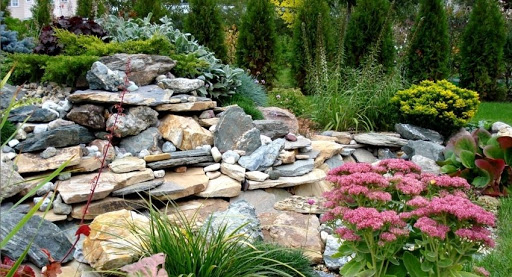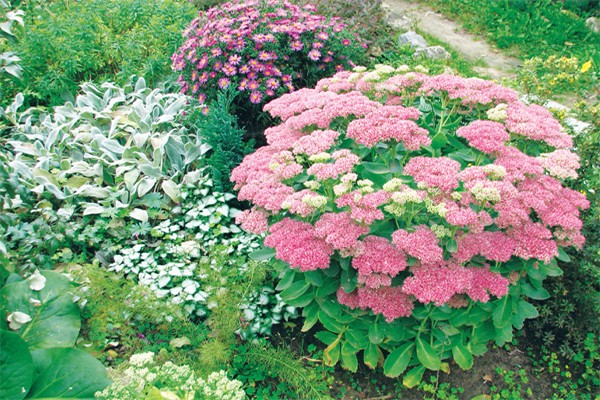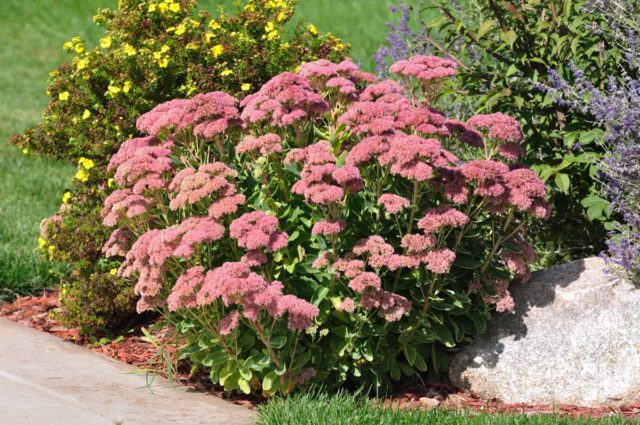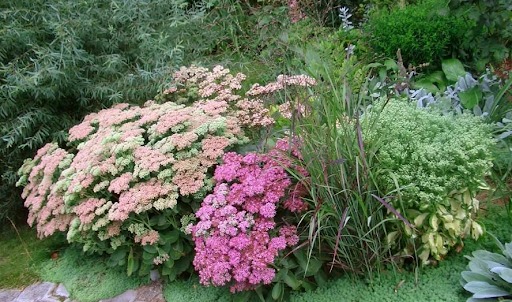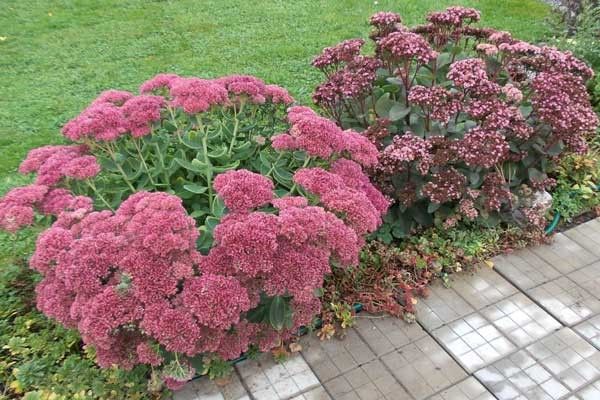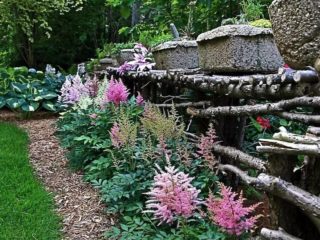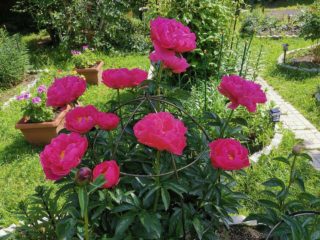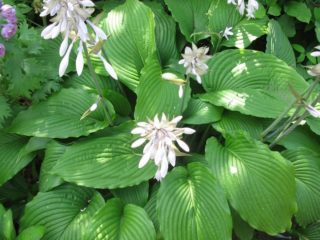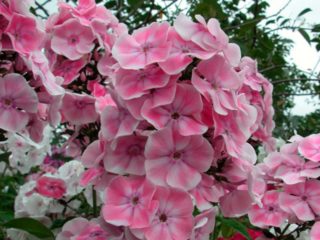Content
Sedum Matrona is a beautiful succulent with lush pink flowers gathered in large umbrellas and dark green leaves on red stalks. The plant is unpretentious, able to take root on almost any soil. It does not need special care - it is enough to regularly weed and loosen the soil.
Description sedum matron
Sedum (sedum) Matrona is a type of perennial succulent from the Tolstyankovye family. The variety was bred in the 1970s. Along with the scientific name Hylotelephium triphyllum "Matrona" has several other common names:
- hare grass;
- squeaky;
- rejuvenated;
- sedum;
- stonecrop ordinary.
This perennial plant is a powerful, compact shrub with straight, cylindrical stems. The height of the stonecrop Matrona is about 40-60 cm. It does not take up much space and at the same time decorates the garden thanks to large (up to 6 cm in length) gray-green leaves with dark red edges, as well as stems of rich purple color.
Produces numerous pink flowers with pointed petals (from late July to mid-September). They are combined into panicle inflorescences, the diameter of which reaches 10-15 cm. Sedum Matron grows for 7-10 years or more, life expectancy directly depends on the quality of care.
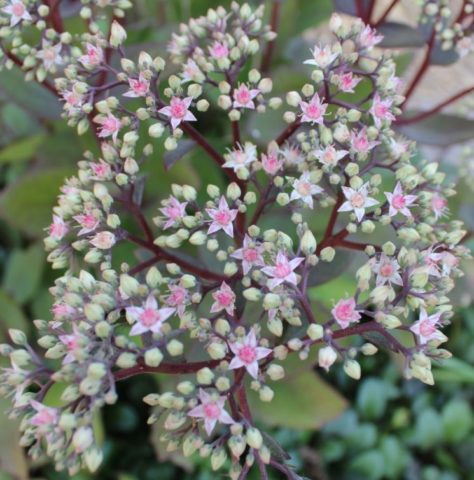
Sedum Matrona attracts attention with numerous graceful pink flowers
Sedum Matrona in landscape design
Sedum Matrona is mainly used as a ground cover. The bush is quite branched, the flowering is lush. Therefore, sedum hides nondescript places well, especially with a dense planting (20-30 cm between plants). Plants can even be planted on rocky soils with crushed stone and gravel.
Since Matrona is short and also produces beautiful pink flowers, she looks good in various compositions:
- Alpine hills: bushes are planted between stones, they hide the soil well and create a general, continuous background.
- Flower garden: in combination with other flowers of the same height.
- Multi-tiered flower beds: in combination with other flowers with height differences.
- Mixborders: compositions from bushes and shrubs.
- To decorate paths, border.
Interesting options for using Seduma Matrona (pictured) will help rationally use culture in landscape design.
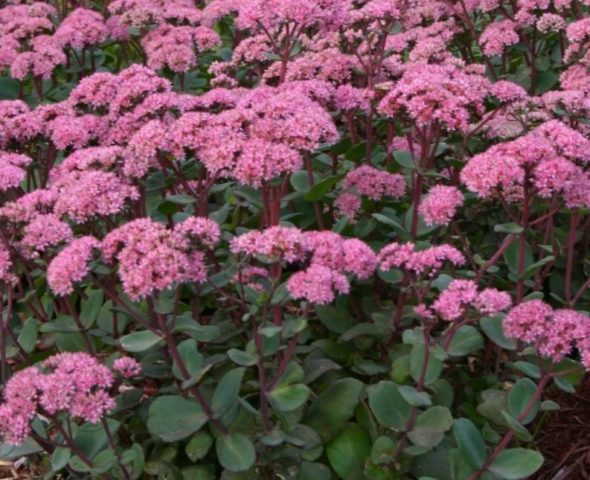
Sedum Matrona looks good in single plantings
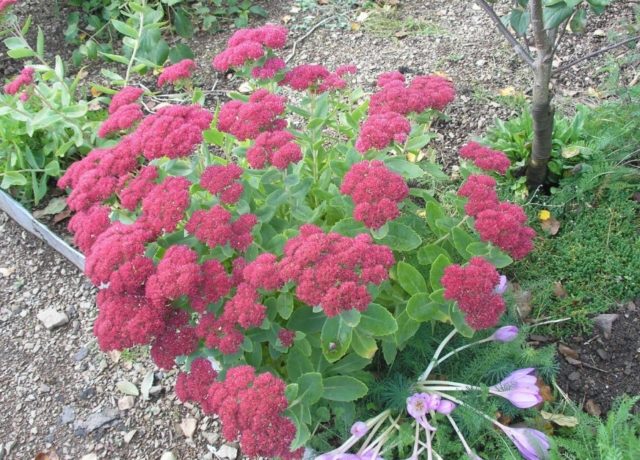
The plant is unpretentious, therefore planting on rocky soil is possible
Breeding features
Sedum Matrona can be diluted in 2 ways:
- With the help of inflorescences (cuttings).
- Growing from seeds.
The first way is the easiest. In August or September, wilted inflorescences are cut off along with the stems. The dry parts are removed, and the green stems (cuttings) are placed in previously settled water. After a few days, cuttings will begin to actively develop on them. Then they can be left in the container until spring, periodically changing the water, or they can be planted in containers with moistened soil. In the spring (in April or May), seedlings of sedum matron are transplanted into open ground.
If, when propagated by cuttings, you can get an exact copy (clone) of the mother plant, then in the case of growing from seeds, the new sedum can have different properties. The seeds are planted in a box or containers with fertile soil in mid-March. First, they are grown under glass, placed on the bottom shelf of the refrigerator for 12-15 days (as far as possible from the freezer). Then the containers are transferred to the windowsill, and after the appearance of 2 leaves of stonecrop, Matron is seated (dived). They grow up in room conditions, and in May they are transferred to open ground.
Optimal growing conditions
It is easy to grow sedum Matron, even in an infertile area. In nature, this plant takes root on stony, sandy soils, it easily tolerates even prolonged droughts due to its ability to accumulate water in the leaves. The bush is winter-hardy, easily copes with frost.
Therefore, the growing conditions are the simplest:
- loose, light soil;
- regular weeding;
- moderate, not too plentiful watering;
- rare fertilization (enough once a year);
- pruning in spring and autumn to form the bush and prepare it for the winter period.
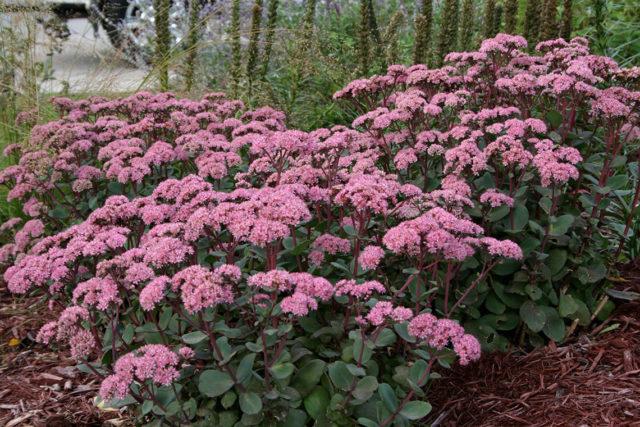
Sedum Matrona does not require special growing conditions
Planting and caring for stonecrop Matrona
It is quite easy to grow sedum. For planting, a well-lit place is selected where the flowering bush will look especially attractive. The soil is pre-dug up and fertilized with organic matter.
Recommended timing
Sedum Matrona belongs to heat-loving plants, therefore, planting in open ground is carried out at a time when the threat of return frosts has completely passed. Depending on the region, this may be:
- end of April - in the south;
- mid-May - in the middle lane;
- the last decade of May - in the Urals and Siberia.
Site selection and soil preparation
The sedum prefers light, fertile soil - classic loams. However, it can grow even on rocky, sandy soils. The landing site should be open, sunny (although weak partial shade is allowed). If possible, this should be a hill, and not a lowland, in which moisture constantly accumulates. It is also worth planting sedum away from deciduous trees and shrubs.
Previously, the site should be cleaned, dug up and any organic fertilizer applied - for example, humus in the amount of 2-3 kg per 1 m2... All large clods of earth are broken to make the soil loose. If the soil is heavy, fine-grained sand is introduced into it - 2-3 whispers per 1 m2.
How to plant correctly
The landing algorithm is simple:
- First, you need to form several small holes at a distance of 30-50 cm. With a tighter planting, you can get a green "carpet" that will completely cover the ground, and with a more rare one - a beautiful row or zigzag, depending on the design features.
- Lay a drainage layer (5-10 cm of pebbles, broken brick, gravel).
- Place the matrona stonecrop seedling so that the root collar is exactly flush with the surface.
- Bury with fertile soil (if the site has not been fertilized beforehand, you can add compost or humus).
- Water abundantly and mulch with peat, humus, pine needles, and other materials.
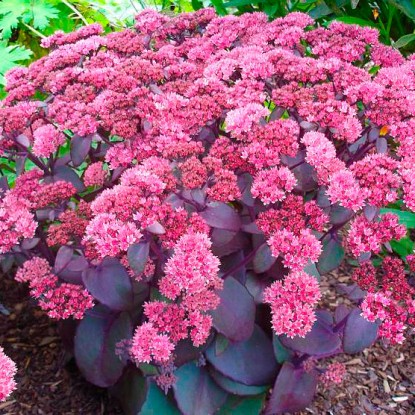
The most important care rules are regular weeding
Growing features
You can grow sedum Matron in almost any area. The plant is undemanding to the quality of the soil and does not need maintenance. It is enough to water it 2 times a month, periodically loosen and weed the soil. Top dressing and special preparation for winter are also optional.
Watering and feeding
Like any other succulents, sedum Matrona does not need to be watered too often.If there is not enough rain, you can give 5 liters of water 2 times a month. In drought, watering should be increased to weekly, but in any case, the soil should not be too wet. It is advisable to stand the water at room temperature for a day. By autumn, watering begins to be reduced, then brought to a minimum. It is not required to spray the bushes - sedum Matron loves dry air.
This plant also does not need constant fertilization. If they were introduced during planting, a new top dressing can be done no earlier than next year. At the beginning of summer, you can close up any organic matter: humus, manure, chicken droppings. It is not worth using complex mineral fertilizer and other inorganic agents.
Loosening and weeding
Sedum Matrona prefers light soil. Therefore, it should be loosened 2-3 times a month, especially before watering and feeding. Then the roots will be saturated with oxygen, moisture and nutrients. Weeding is carried out as needed.
To keep weed growth to a minimum, it is recommended to lay a layer of mulch.
Pruning
Stonecrop pruning is carried out regularly - in autumn and spring. When preparing for winter, it is enough to remove all old shoots, leaving stems 4-5 cm tall. In the spring, old leaves, damaged branches and strongly prominent young shoots are removed, giving the bush a shape. It is advisable to have time to do this before the beginning of the swelling of the kidneys.
Wintering
In the south and in the middle zone, sedum Matrona does not need special preparation for winter. It is enough to cut off old shoots, leaving 4-5 cm above the soil surface. Then cover with dry foliage, spruce branches, hay. In early spring, the mulch must be removed so that the shoots of the plant do not overheat due to accumulated moisture.
In the Urals, Siberia and other regions with severe winters, along with the actions described, it is required to make a shelter. To do this, you can lay agrofibre or burlap on top and fix them on the surface with bricks.
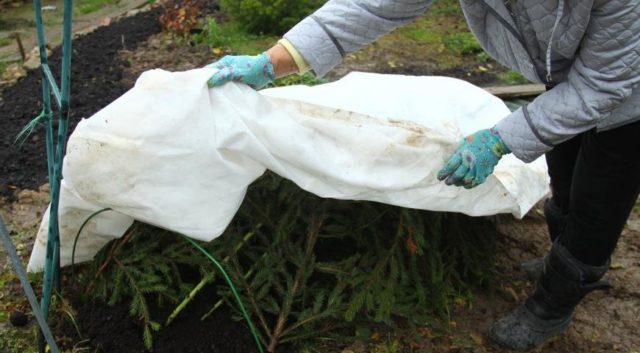
Shelter is made only for young bushes, and adult specimens easily overwinter under a layer of ordinary mulch.
Pests and diseases
Sedum Matrona has good resistance to various diseases, including fungal diseases. Occasionally, it can suffer from rot, which usually appears due to excessive watering.
As for pests, most often the following insects settle on the leaves and stems of the plant:
- aphid;
- furrowed weevil (weevil);
- thrips.
You can deal with them with the help of insecticides, which are usually used to treat black currant bushes:
- Aktara;
- Tanrek;
- "Confidor Extra";
- "Spark".
Getting rid of weevils is not always easy. These are nocturnal insects, for catching which you can spread white paper under the plants. Then, late at night, shake them off the bushes and kill them.
Conclusion
Sedum Matrona allows you to decorate your garden thanks to its attractive leaves and flowers that appear until the first frost. The plant is unpretentious, does not need feeding and watering. The only important condition for growing is regular weeding and loosening of the soil.
